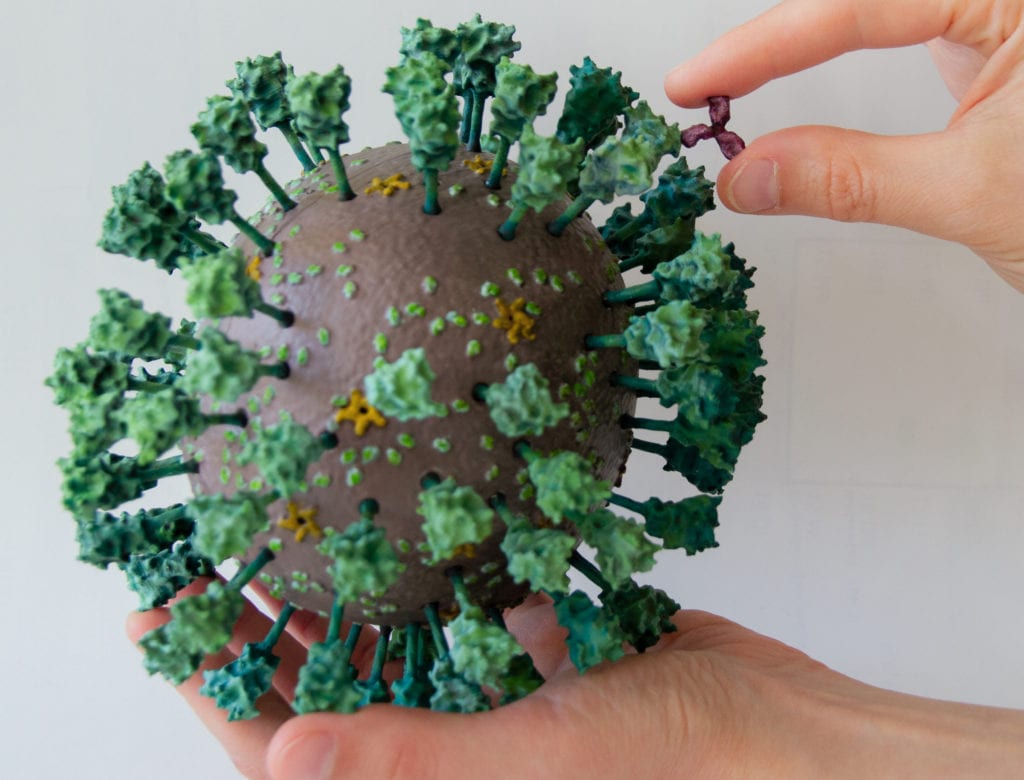
If you can’t see it, it’s not there, right? Wrong! But if you look at it in this way, its mode of action becomes clear: The SARS-CoV-2 virus in 3D print – for non-scientists and pharmaceutical research.
If the real virus were this big, it certainly could not have spread so quickly. But it is small, very small. Neither the naked eye nor many microscopes can see it, and so the current threat from COVID-19 and its pathogen remains invisible. This was reason enough for the international Corona Structural Task Force led by scientist Dr. Andrea Thorn from the Rudolf Virchow Center at the University of Würzburg, Germany, to develop a 3D model of the new corona virus. At 17 cm, this model is so big you can pick it up.
The aim of the scientists is not only to make the SARS-CoV-2 virus understandable for non-scientists in a playful way, but also to bundle international research results. Their research is intended to accelerate the development of a vaccine and a therapy.
Expertise of an international team
To this end, 23 employees from seven nations and a wide variety of specialized disciplines are working closely together in a network. They come from fields such as chemistry, physics, computer science and structural biology. Together, the researchers are deciphering the molecular structures of SARS-CoV-2 – of which, by the way, there are over 500 to date – and are analyzing the arrangement of the individual atoms in its molecules. This international team of researchers is constantly improving its molecular models and making the latest data and findings available to all drug developers worldwide.
In an interview with the German radio station Bayerischer Rundfunk, structural biologist Dr. Andrea Thorn said: “We first build these models on the computer and once we have done that, it can be determined where a drug can attach itself, for example. But to do this, we first have to figure it out. This means: This [pointing to a 3D model] is the lock and the drug would be the key. These are the best prerequisites for developing a vaccine or therapy against COVID-19 as quickly as possible.
Comprehensible science
The findings of the Corona Structural Task Force, which communicates daily via video conference, also flowed into the design of the current 3D model presented recently. It realistically depicts on a scale of 1:1,000,000 the proportions and structures of the virus. And this is what it looks like: On the one hand, the virus envelope has green spikes and its surface has two other types of light green and yellow protein molecules (see figure). A particular finding: The virus is not, as often depicted, exactly round or symmetrical, but can vary in shape and size.
Instructions for 3D printing
The research team has another special feature up its sleeve. On its homepage, it has published instructions for printing a 3D model of the SARS-CoV-2 virus. They have also uploaded tips on how to paint it and the necessary files to do so. And of course you can also obtain more information about the virus there, including a presentation of the infection cycle according to the current state of knowledge, further blog posts and the latest information on the molecules of the virus.
“We hope that this will help us make the virus more understandable,” says Thorn, who would like to see the model give children and adults an insight into the structural biology of the corona virus.
Background information: The research groups at the Rudolf Virchow Center are working on different proteins with a high relevance for medical questions, diseases and cell functions
Also interesting: Fewer animal experiments and more research thanks to 3D printing


